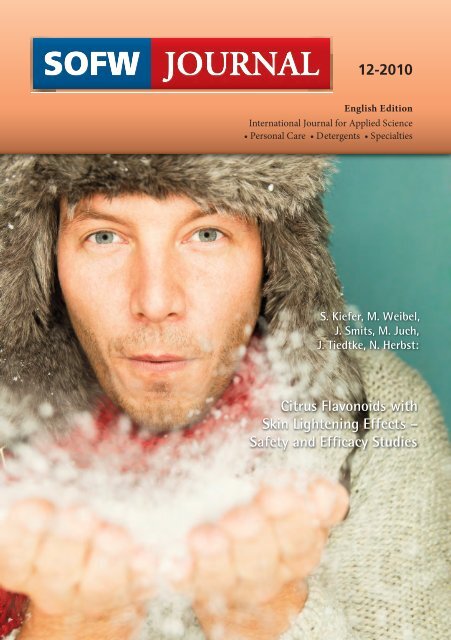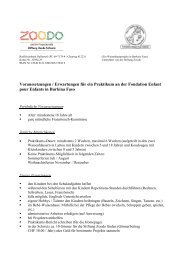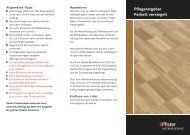12-2010 Citrus Flavonoids with Skin Lightening Effects ... - Hostpoint
12-2010 Citrus Flavonoids with Skin Lightening Effects ... - Hostpoint
12-2010 Citrus Flavonoids with Skin Lightening Effects ... - Hostpoint
Create successful ePaper yourself
Turn your PDF publications into a flip-book with our unique Google optimized e-Paper software.
<strong>12</strong>-<strong>2010</strong>English EditionInternational Journal for Applied Science• Personal Care • Detergents • SpecialtiesS. Kiefer, M. Weibel,J. Smits, M. Juch,J. Tiedtke, N. Herbst:<strong>Citrus</strong> <strong>Flavonoids</strong> <strong>with</strong><strong>Skin</strong> <strong>Lightening</strong> <strong>Effects</strong> –Safety and Efficacy Studies
COSMETICSSKIN LIGHTENINGS. Kiefer, M. Weibel, J. Smits, M. Juch, J. Tiedtke, N. Herbst*<strong>Citrus</strong> <strong>Flavonoids</strong> <strong>with</strong> <strong>Skin</strong> <strong>Lightening</strong> <strong>Effects</strong> –Safety and Efficacy Studies IntroductionWith ageing of the skin pigmentary disorderssuch as age spots, melasma, anduneven skin tone become more frequent.An even, bright and unblemished skin isone of the main criteria for a younglooking appearance (1-3). Hence skinlightening products form a major segmentin the cosmetic industry and are apart of many anti-ageing products thatreach the market every year.AbstractMelanin, the substance responsible forthe pigmentation of the skin, is producedto protect the DNA from harmful, mutagenicUV radiation. Age spots or solarlentiges are age-related and UV irradiation-inducedpigmented spots that usuallyoccur on sunlight-exposed areassuch as the face, the back of the hands,and the upper chest.The rate-limiting enzyme in melanin formationis polyphenol oxidase tyrosinase(EC 1.14.18.1) which catalyses the oxida-Ayouthful appearance is not only related to the absence of wrinklesbut also to skin radiance and an even skin tone. Many cosmetic ingredientsare used to lighten skin by the inhibition of tyrosinase, therate-limiting enzyme in melanin formation. <strong>Flavonoids</strong>, as major constituentsof the human diet, have many well-known beneficial qualities.The aim of this study was to find the ideal composition of flavonoids fromvarious citrus extracts for an effective skin lightening cosmetic ingredient.A chosen blend of citrus extracts was tested for safety and in vitro efficacy.No cytotoxic effects up to 0.8mg/ml could be detected and inhibition ofhuman tyrosinase was 60% at 0.4mg/ml. The blend of citrus extracts wasliposomal-encapsulated, incorporated into a cosmetic formulation at 1%,and then tested for stability and skin irritation capacity, as well as eye irritationand mutagenic potential and exhibited a very good safety profile.Finally the product was studied in vivo on Caucasian skin for efficacy during56 days and showed marked skin brightening effects at a concentrationof 1% (0.4mg/ml).This liposomal-encapsulated citrus flavonoid blend is effective at 1% in acosmetic formulation to fade age spots and brighten skin tone.tion of tyrosine to dopaquinone (4). Thesubsequent steps of melanin formationfrom dopaquinone can occur spontaneouslyat physiological pH. Dopaquinoneis oxidized to dopachrome and throughfurther oxidation reacts to melanin.Many of the currently used depigmentingagents are tyrosinase inhibitors, asit seems the most straightforward wayto inhibit melanin formation. Althoughmore recent in-depth knowledge ofmelanocyte biology and the processesunderlying melanin formation has producedother interesting targets for thetreatment of hyper-pigmentation, suchas the inhibition of translation and maturationof tyrosinase, stimulation of degradationand acceleration of skin turnover.The best known skin whitening agent ishydroquinone, which has been used forover 50 years now although some controversyabout it has come up in recentyears. Long term use of high concentrationsof hydroquinone can produce sideeffects like ochronosis, a thickening anddarkening of skin, especially of darkskinnedindividuals (5) and general safetyconcerns have been brought up byregulatory agencies all over the world.Therefore there is still a need for safe andeffective skin lightening products andthe hunt for natural skin lighteners (6) isongoing.<strong>Flavonoids</strong> form major constituents ofthe human diet as they contribute to theflavour and colour of many fruits andvegetables. Their beneficial antioxidanteffects are thoroughly studied and established.The highest content of citrus flavonoidscan be found in unripe citrus fruits (7).46 SOFW-Journal | 136 | <strong>12</strong>-<strong>2010</strong>
COSMETICSSKIN LIGHTENINGThese unripe fruits can be collected bythinning out, which is necessary for agood harvest of ripe fruits later on (8).Whole ground fruits are extracted <strong>with</strong>a water methanol mixture to yield thehighest flavonoid content.The aim of this study was to find the idealcomposition of flavonoids from variouscitrus fruit extracts to use as an effectiveskin lightening cosmetic ingredient. Materials and MethodsAll solvents from Merck, all other chemicalsfrom Sigma AldrichRaw materialThe various citrus extracts were boughtfrom different extract manufacturersand analyzed by HPLC for their contentof naringin, narirutin, hesperidin, andneohesperidin.HPLC instrumentationHPLC separation was carried out on aSurveyor HPLC system <strong>with</strong> degasser, binaryhigh pressure mixing pump, columnthermostat, and auto sampler. The HPLCwas coupled to a DAD detector and dataacquisition and processing was performedusing ChromQuest ChromatographyData System (CDS) (all ThermoFisher Scientific).Separation of flavonoidsOn a C18 column (Utisphere OBD, <strong>12</strong>0Å,150 x 4.6 mm, 5µm) an isocratic elution<strong>with</strong> 75% water, 10% methanol, 10%acetonitrile, and 5% acetic acid 99%was performed <strong>with</strong> a flow of 1 ml/minand subsequent UV detection at 285 nm.Tyrosinase inhibitionMushroom tyrosinase (333 U/ml, EC1.14.18.1, Sigma Aldrich, Switzerland)was incubated in 18 mM phosphatebuffer, extracts and tyrosine solution (finalconcentration of 1 mM) were addedand absorbance was measured over 5hours at 490 nm.Cellular human tyrosinase activity testNormal human epidermal melanocytes(NHEM, Bioalternatives, France) were incubatedfor 72 hours <strong>with</strong> test compoundand control. After incubation, culturemedium was removed and cells washed<strong>with</strong> PBS. The tyrosinase enzyme was extracted<strong>with</strong> Triton X in PBS and then incubated<strong>with</strong> 2 mM L-3,4-dihydroxyphenylalanine(L-DOPA) as substrate. Afterincubation enzymatic activity was measuredat 540 nm (ThermoMax micro platereader, Molecular Devices).CytotoxicityNormal Human Epidermal Melanocytes(NHEM, Bioalternatives, France) wereincubated <strong>with</strong> concentrations from0.0015 to 1.14 mg/ml of flavonoid mixturefor 72 hours. Then a solution of0.5 mg/ml 3-(4,5-dimethylthiazol-2-yl)-2,5-diphenyltetrazolium bromide (MTT)was added, after incubation at 37 ° C for4 hours, the media was discarded and100 ul DMSO was added to each well. Theoptical density of the dissolved residueswas measured at 540 nm (Microplatereader, Molecular devices).Liposomal encapsulationThe flavonoid mixture was mixed <strong>with</strong>glycerin, lecithin, tocopherol, sodiumascorbate, and homogenized <strong>with</strong> a highpressure homogenizer (Microfluidics,Lampertheim, Germany). Subsequentlythe liposome size was determined usinga Zetasizer Nano ZS90S from Malvern Instruments(Worcestershire, United Kingdom).Formulation1% of the liposomal solution was incorporatedinto a lotion (Table 1) for applicationstudies (patch tests and in vivo efficacy).The formulation was tested forstability towards temperature and time.Patch testsFor both, single and repeated patch tests25 healthy volunteers between 18 and60 years were selected. The dorsal skinwas cleaned <strong>with</strong> 70% alcohol beforeComponent INCI Weight (g) FunctionWater Aqua 78.6 SolventNaOH 10% Aqua, Sodium Hydroxide 0.5 pH-adjustmentKeltrol CG SFT Xanthan Gum 0.4 Emulsion stabilizerCrodafos CES Cetearyl Alcohol, Dicethyl Phosphate, Ceteth-10 Phosphate 3.0 EmulsifierMyritol 318 Caprylic/Capric Triglyceride 13.0 <strong>Skin</strong>-conditioning agentPreservative Phenoxyethanol, Ethylhexylglycerin q.s. PreservativeSilicone Oil Dimethicone 0.5 Antifoaming agentShea Butter Butyrospermum Parkii (Shea Butter) 3.0 <strong>Skin</strong>-conditioning agentFlavonoid mixture, Glycerin, Aqua, Lecithin, <strong>Citrus</strong> Paradisi (Grapefruit) Fruit Extract, 1.0 ActiveCitrolumine 8 <strong>Citrus</strong> Aurantium Amara (Bitter Orange) Fruit Extract, SodiumAscorbate, Tocopherol, Heliantus Annus (Sunflower) Seed OilTotal 100.0Table 1 Frame formulation for the liposomal encapsulated citrus flavonoid blend, as used in the application studies48 SOFW-Journal | 136 | <strong>12</strong>-<strong>2010</strong>
COSMETICSSKIN LIGHTENINGproduct application and then 1% of liposomal-encapsulatedflavonoid mixturein a lotion was applied using a FinnChamber (7 mm). The product was left incontact <strong>with</strong> the skin for 48 hours (singlepatch test) or 24 hours and reapplied4 times (repeated patch test). The cutaneousreactions were evaluated 15 minutes,1 hour, and 24 hours after removalof the product. One chamber <strong>with</strong> distilledwater was used as negative controland for the single patch test only a positivecontrol was applied <strong>with</strong> 0.5% sodiumdodecyl sulphate (SDS).Application studyCaucasian skin: Six healthy female volunteersof Caucasian skin type (all Fitzpatrickskin types II) were recruited forapplication of the lotion or a control(formulation <strong>with</strong>out active ingredient).The cream was applied twice a day during8 weeks on the back of the hand andthe face. Melanin Index was measured onthe back of the hand and the face <strong>with</strong>a <strong>Skin</strong> Pigment Analyzer, SPA99 (Courage& Khazaka, Köln, Germany) and photographswere taken from the face andback of the hand <strong>with</strong> VisioFace Quick(Courage & Khazaka).Asian skin: Six healthy female volunteersof Asian skin type were recruitedfor application of the lotion on the externalforearm. The lotion was appliedtwice daily during 8 weeks. <strong>Skin</strong> colorwas measured <strong>with</strong> a Chromameter CR300(Konica Minolta, Dietikon, Switzerland).All volunteers were measured and photographed3 times; at day 0 (baseline),day 28, and day 56.Tyrosinase inhibition(mushroom tyrosinase)Inhibition of mushroom tyrosinase wastested in a concentration range from0.025 to 3 mg/ml. Up to 1 mg/ml inhibitionincreased dose dependently up to40% of untreated control, in concentrationhigher than 1 mg/ml there was nofurther increase possible (Fig. 2). Theflavonoid mixture showed an estimatedIC50 of 0.75mg/ml.- Fig. 1 HPLC chromatogram of the flavonoid mixtureCellular human Tyrosinase activity testTyrosinase activity was tested after incubationof NHEM <strong>with</strong> 0.004 to 0.4 mg/mlflavonoid mixture for 72 hours and subsequenttyrosinase extraction of thecells. As a control 0.02 mg/ml of kojic acidwas used. A concentration of 0.004 mg/ml of flavonoid mixture reduced the tyrosinaseactivity to 66%, 0.04 mg/ml to65%, and 0.4 mg/ml to 40%, whereas kojicacid reduced tyrosinase activity to61% at 0.02mg/ml (Fig. 3).Viability/ CytotoxicityUp to 0.4 mg/ml flavonoid mixture viabilitywas increased up to 130%, at1.<strong>12</strong> mg/ml a reduction of viability to83% was measured (Fig. 4). A concentrationof 3.3 mg/ml resulted in no remainingviability (data not visible). ResultsRaw materialThe various citrus extracts were tested bychromatographic separation for theircontent of narirutin, naringin, hesperidin,and neohesperidin.Two extracts were chosen, one from unripecitrus paradisi (grapefruit) and onefrom unripe citrus aurantium amarum(bitter orange) fruit and mixed. The resultingmixture of raw materials resultedin the following flavonoid contentof 4.9% narirutin, 22.0% naringin, 1.0%hesperidin, and 5.3% neohesperidin (Fig. 1).- Fig. 2 Mushroom tyrosinase inhibition of flavonoid mixture50 SOFW-Journal | 136 | <strong>12</strong>-<strong>2010</strong>
COSMETICSSKIN LIGHTENINGSafety testsAmes reverse mutation assay (OECD No.471) using Salmonella typhimurium andEscherichia coli showed no mutagenicpotential of the liposomal-encapsulatedflavonoid mixture.The bovine corneal opacity and permeabilityassay (BCOP, OECD No. 437) of theliposomal-encapsulated flavonoid mixturerevealed no eye irritation potentialof the product.Liposomal encapsulationLiposomes showed an average particlesize of <strong>12</strong>0 nm which was stable overseveral production batches. They formeda transparent, stable solution and nopreservation was necessary to keep thesolution from microbiological conta -mination. A Pharmacopoeia Europea 6preservation test for topical productswas performed and received a grade Bevaluation.- Fig. 3 Tyrosinase inhibition of cellular tyrosinase extracted from NHEM comparedto untreated controlStability of frame formulationThe formulation for the applicationstudy was stable for 6 month at roomtemperature, at 40°C, and at 2-8°C in therefrigerator.Patch testsThe single and repeated human patchtests showed no irritation and sensitizationpotential of the liposomal-encapsulatedflavonoid mixture in a lotion at 1%,which corresponds to 0.4 mg/ml offlavonoid mixture.- Fig. 4 MTT viability assay <strong>with</strong> flavonoid mixture from 0.0015 mg/ml up to 1.116 mg/ml Application StudyCaucasian <strong>Skin</strong>The application study on Caucasian skin(n=6) showed skin lightening effects andage spots brightening after 28 and 56days of application compared to baseline.The effects on age spot brighteningwere slightly more apparent than thelightening effects on skin tone. Both onhand (Fig. 5) and face (Fig. 6) the resultingbirightening effects were in thesame range. Fig. 7 shows the spot-fadingand skin brightening effects of aVisoFace Quick picture of the back of thehand on day 0 and day 56.- Fig. 5 <strong>Skin</strong> brightening effect of liposomal-encapsulated flavonoid mixture at 1%in a lotion (corresponding to 0.4 mg/ml flavonoid mixture) applied on the back ofthe hand twice daily for 28 and 56 days compared to baseline (day 0)SOFW-Journal | 136 | <strong>12</strong>-<strong>2010</strong> 51
COSMETICSSKIN LIGHTENINGAsian <strong>Skin</strong>After promising results on Caucasianskin an additional study on the externalforearm of Asian volunteers (n=3) wasperformed and showed a lightening effectcompared to baseline (day 0), whichwas significantly present after 56 days(Fig. 8). DiscussionThe flavonoid mixture was effective invitro. Good inhibtion has been shown inthe mushroom tyrosinase enzyme inhibitiontest <strong>with</strong> an estimated IC50 ofabout 0.75 mg/ml.The cellular human tyrosinase inhibitionassay resulted in stronger tyrosinase inhibition,there the estimated IC50 was0.24 mg/ml of flavonoid mixture. Originallythe potential lighthening effect ofcitrus flavonoids was discovered by mushroomtyrosinase inhibition assay (9).A range of tests showed that the citrusflavonoid blend is safe for application onskin. No cytotoxicity has been observedin concentrations that were applied. Inthe single and repeated patch tests no irritationor sensitisation potential wasfound and also no mutagenic potential(as tested by Ames Test, data not shown)and no eye irritation was detectable(BCOP test, data not shown). These findingsshow the excellent safety profile ofthe flavonoid blend for use as a cosmeticingredient.In vivo studies showed that it was veryeffective in brightening the skin tone andhad an even stronger effect on the fadingof age-spots, resulting in a more evenskin tone. To get more accurate data <strong>with</strong>lower standard deviations a bigger study<strong>with</strong> at least 20 volunteers would be necessary.The high standard deviation wasdue to the small test groups (n=6 forCaucasian and n=3 for Asian <strong>Skin</strong>). After28 days effects were already visible andwere enhanced after 56 days, thus implyingthat stronger brightening effectscan be obtained after longer application.These data suggest that the liposomalencapsulatedcitrus flavonoid blend(Citrolumine 8 from Cosmetochem AG,Switzerland) can be used at 1% in a cosmeticlotion as a very safe and effectiveskin lightening ingredient.- Fig. 6 <strong>Skin</strong> brightening effect of liposomal-encapsulated flavonoid mixture at 1%in a lotion (corresponding to 0.4 mg/ml flavonoid mixture) applied to the face twicedaily after 28 and 56 days compared to baseline (day 0)Day 0 Day 56- Fig. 7 <strong>Skin</strong> brightening and spot-fading effect of liposomal-encapsulated flavonoidmixture at 1% in a lotion (corresponding to 0.4 mg/ml flavonoid mixture) appliedto the back of the hand twice daily for 56 days. Left picture baseline at day 0, rightpicture after twice daily application during 56 days- Fig. 8 <strong>Skin</strong> brightening effect of liposomal-encapsulated flavonoid mixture at 1%in a lotion (corresponding to 0.4 mg/ml flavonoid mixture) applied to the externalforearm of asian volunteers twice daily after 28 and 56 days compared to baseline(day 0). After 56 days a sigificant brightening effect can be measured52 SOFW-Journal | 136 | <strong>12</strong>-<strong>2010</strong>
COSMETICSSKIN LIGHTENINGAcknowledgementsThese investigations were realized andfunded by Cosmetochem InternationalAG, Switzerland.The authors’ would like to thank Dr. RudiWajda from Lipoid GmbH, Ludwigshafen,for liposomal encapsulation andmeasurements and Daniel Lisibach fromCosmetochems analytical lab for all theHPLC analyses.References(1) Fink B, Matts PJ. The effects of skin colour distributionand topography cues on the perceptionof female facial age and health. J Eur AcadDermatol Venereol 2008;22 (4):493-8(2) Gunn DA, Rexbye H, Griffiths CE, Murray PG,Fereday A, Catt SD, Tomlin CC, StrongitharmBH, Perrett DI, Catt M, Mayes AE, MessengerAG, Green MR, van der Ouderaa F, Vaupel JW,Christensen K. Why some women look youngfor their age. PLoS One 2009;4 (<strong>12</strong>):e8021(3) Matts PJ, Fink B, Grammer K, Burquest M. Colorhomogeneity and visual perception of age,health, and attractiveness of female facial skin.J Am Acad Dermatol 2007;57 (6):977-84(4) Chang TS. An updated review of tyrosinase inhibitors.Int J Mol Sci 2009;10 (6):2440-75(5) Parvez S, Kang M, Chung HS, Cho C, Hong MC,Shin MK, Bae H. Survey and mechanism of skindepigmenting and lightening agents. PhytotherRes 2006;20 (11):921-34(6) Smit N, Vicanova J, Pavel S. The hunt for naturalskin whitening agents. Int J Mol Sci2009;10 (<strong>12</strong>):5326-49(7) Kubo M, Fujita T, Nishimura S, Tokunaga M,Matsuda H, Tomohiro N, Sakai K, UtsunomiyaN. Seasonal variation in anti-allergic Activity of<strong>Citrus</strong> fruit and Flavonone Glycoside Content.Nat Med 2004;58 (6):284-94(8) Itoh K, Hirata N, Masuda M, Naruto S, MurataK, Wakabayashi K, Matsuda H. Inhibitory effectsof <strong>Citrus</strong> hassaku extract and its flavanoneglycosides on melanogenesis. BiolPharm Bull 2009;32 (3):410-5(9) Sasaki K, Yoshizaki F. Nobiletin as a tyrosinaseinhibitor from the peel of <strong>Citrus</strong> fruit. BiolPharm Bull 2002;25 (6):806-8* Authors’ address:Sabine Kiefer, Michaela WeibelJulian Smits, Mathias JuchJane Tiedtke, Norbert HerbstCosmetochem International AGSennweidstrasse 44/4663<strong>12</strong> SteinhausenSwitzerlandEmail: sabine.kiefer@cosmetochem.ch54 SOFW-Journal | 136 | <strong>12</strong>-<strong>2010</strong>




